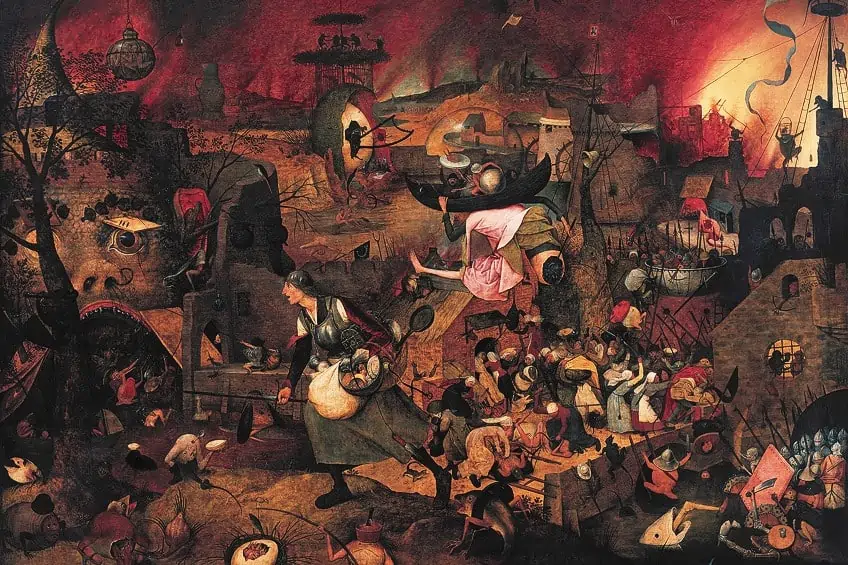Famous Paintings of Hell – Discover Scary Depictions of Hell in Art
Throughout the history of art, humans have created terrifying artworks that portray depictions of hell. Why are there so many depictions of hell in art, and what was the mindset of the individuals who produced hell paintings? Whether we are referring to older Renaissance paintings of hell or more contemporary hell artworks, many of these pieces were not created by sinister people at all, but rather were commissioned or created by God-fearing individuals who wanted to warn others of the perils of what awaited those who do not live a good life. In this article, we will look at the most famous paintings of hell, and discover the reasons for their creation.
Contents
- 1 Depictions of Hell in Art
- 2 Famous Paintings of Hell
- 2.1 Crucifixion and Last Judgement Diptych (c. 1430 – 1440) by Jan van Eyck
- 2.2 The Map of Hell (1485) by Sandro Botticelli
- 2.3 The Garden of Earthly Delights (c. 1490 – 1510) by Hieronymus Bosch
- 2.4 The Haywain Triptych (1516) by Hieronymus Bosch
- 2.5 Dull Gret (1563) by Pieter Bruegel the Elder
- 2.6 Dante and Virgil in the Underworld (1622) by Filippo Napoletano
- 2.7 Satan Calling Up His Legions (1804) by William Blake
- 2.8 Pandemonium (1841) by John Martin
- 2.9 Dante and Virgil in Hell (1850) by William-Adolphe Bouguereau
- 2.10 Inferno (1908) by Franz von Stuck
- 3 Frequently Asked Questions
Depictions of Hell in Art
Darren Oldridge once wrote, “it is harder to imagine heaven than hell” – perhaps a reflection of our flaws and imperfections. One could say that creating misshapen and weird creatures and scenes is not as challenging to portray as scenes of idealized beauty and perfection.
Or perhaps, creating hell paintings was a way for artists to express the darker aspects of their creative psyches within the accepted form of “religious art”.
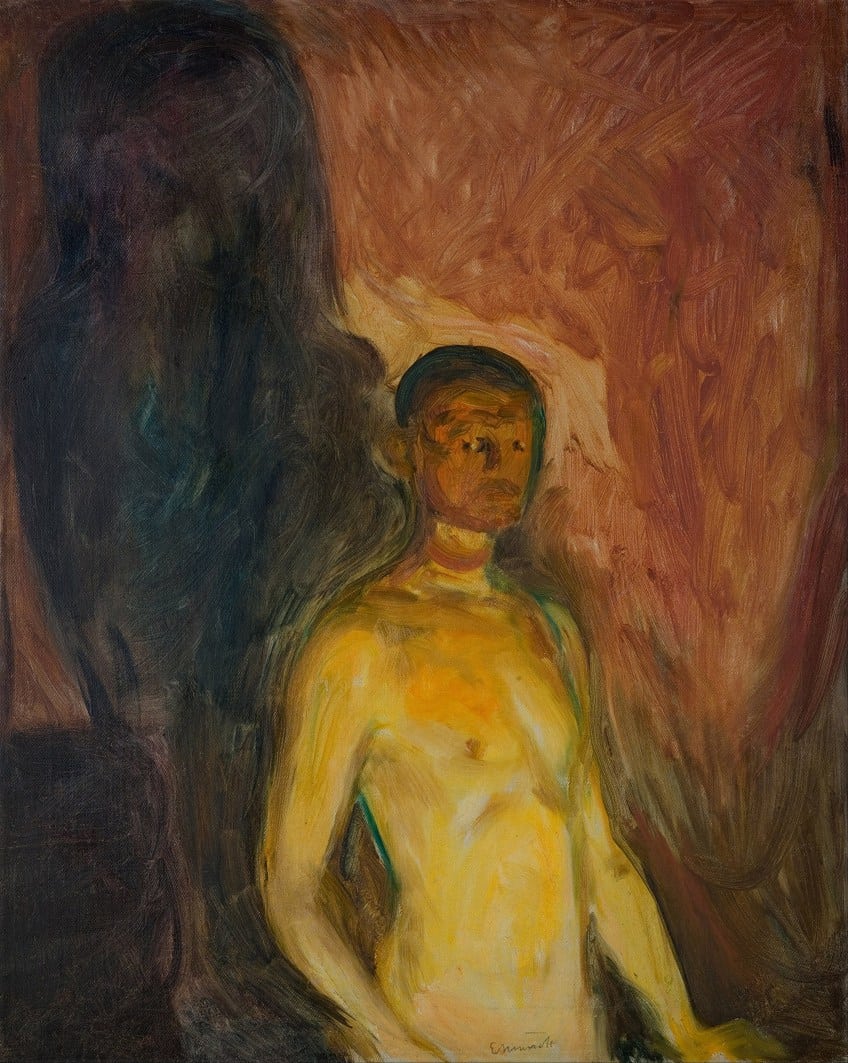
Although over time, the collective belief of ideas such as heaven and hell have significantly declined, during the periods of religious indoctrination and influence, depictions of hell in art were very common. Religious texts were not the only source for these terrifying artworks though, and many hell artworks were based on tales and descriptions taken from literature from around the world and ancient mythology stories.
Famous Paintings of Hell
Many depictions of hell came from pre-Christian sources, such as Norse myths and Pagan legends. Once Christianity became the dominant religion, there was an attempt to incorporate the older stories into the Christian narrative as they were so much a part of the culture’s consciousness that trying to whitewash their existence would have been impossible. So, many older stories and depictions of the underworld from previous eras were influential on the early Christian depictions of hell in art, and many symbols, characters, and tales from these previous beliefs can be observed in these initial works.
Crucifixion and Last Judgement Diptych (c. 1430 – 1440) by Jan van Eyck
| Date Completed | c. 1430 – 1440 |
| Artist | Jan van Eyck (1390 – 1441) |
| Medium | Oil on wood |
| Location | Metropolitan Museum of Art, New York |
The Crucifixion and Last Judgement Diptych is not only among the most famous paintings of hell, but it is also a famous painting depicting heaven in the same piece. Produced over two large panels, the artist wanted to portray the whole supernatural realm in his painting. He did not work on the heaven and hell artwork on his own though, and his workshop apprentices helped him complete the panels.
The left panel on the left depicts Christ on the cross, accompanied by two other figures – the crucified thieves from the biblical account.

A group of people watches as Jesus is pierced in the side with a spear. The right panel depicts Christ ascending to heaven, surrounded by angels at the top, while the bottom of the panel is filled with ghastly images of the condemned. New technical analysis of the paintings has revealed that the artworks were not always a diptych though, and were either once part of the doors of a shrine, or the two sides of a triptych.
The Map of Hell (1485) by Sandro Botticelli
| Date Completed | 1485 |
| Artist | Sandro Botticelli (1445 – 1510) |
| Medium | Oil on canvas |
| Location | Vatican Library, Rome |
One of the most renowned depictions of hell is attributed to Sandro Botticelli. This painting was inspired by Dante’s Divine Comedy, as it depicts a realistic, external portrayal of hell’s various descending levels. Originally produced on a large canvas, it graphically depicts each worsening level that one descends through as one travels through hell.
The painting is one of a series of works that were part of a manuscript that is considered among the Renaissance artist’s finest achievements.
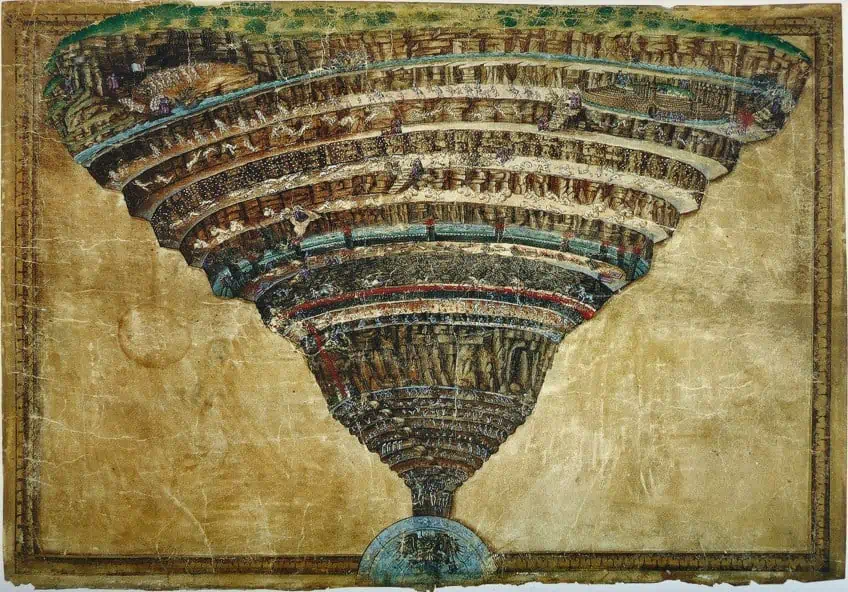
From a distance, it almost looks as though Botticelli had painted some kind of tornado, but once one looks closer, you can fully appreciate all the finer details and complex story that he was trying to convey. He was less interested in depicting hell in the fire and brimstone manner that many other artists have done and rather wanted to portray Dante and Virgil’s entire journey in one painting in a way that was respectful of Dante’s vision. For a while, the paintings were lost but then reappeared in the 19th century.
The artist’s idea was to illustrate the entire Divine Comedy (1320), which at the time was seen as an extremely ambitious undertaking.
Although it is not known exactly when he started the series of paintings, it is believed that it took several years to complete as there is an observable development in his style throughout the paintings when viewed in the sequence that they were created. It is estimated that it took the artist around 20 years to complete this body of work. It was only in 2000 that all 92 of the paintings were exhibited together for the first time.
The Garden of Earthly Delights (c. 1490 – 1510) by Hieronymus Bosch
| Date Completed | c. 1490 – 1510 |
| Artist | Hieronymus Bosch (1450 – 1516) |
| Medium | Oil paint |
| Location | Museo Nacional del Prado, Madrid |
Hieronymus Bosch touched on the topic of hell in several of his artworks, and this specific depiction is from the third panel of his famous triptych. The whole idea of Hell was especially suitable for the works of Hieronymus Bosch, who reveled in life’s horrors and frequently included religious themes in his works. Bosch was an artist who valued expression and creativity, and he would re-invent numerous biblical topics that had previously been employed by other artists. While artists such as Van Eyck focused on technical accuracy, Bosch took pre-existing subjects and added his amazing creativity on top.
The entire artwork, which comprises three panels, depicts the various stages of man’s creation and downfall, from his beginnings in paradise in the first panel to his descent into hell in the last panel.
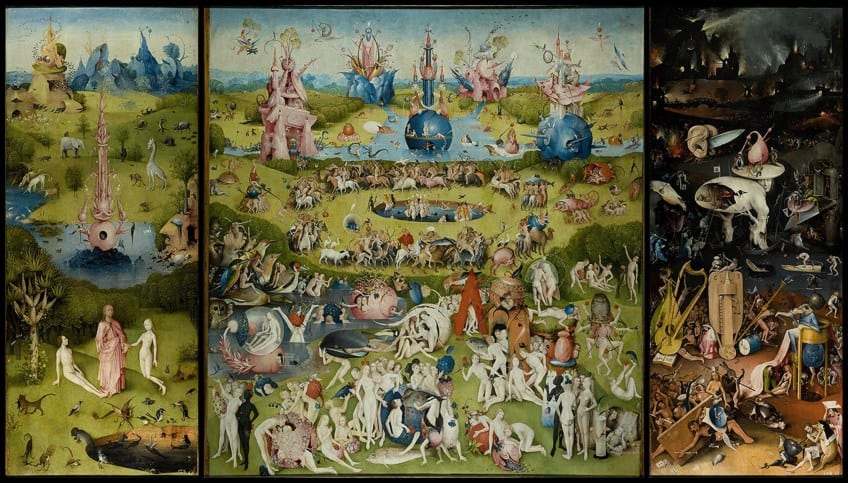
The significance of this bizarre hell painting will be discussed for as long as art historians exist, but its emotional intensity is obvious. Bosch sought to create art that could both enlighten and fascinate. He wished for a world with a strong moral compass and thought that his grandiose, often violent message would guide people in the right direction. While considerable studies have been undertaken on the triptych and, in particular, the Hell panel, most scholars have determined that Bosch’s approach to Bible interpretations is fairly representative of the era.
The emotive creative style in which he presents these moments, willing to shock, even bewilder his viewers, is the distinguishing feature of his hell artworks.
The Haywain Triptych (1516) by Hieronymus Bosch
| Date Completed | 1516 |
| Artist | Hieronymus Bosch (1450 – 1516) |
| Medium | Oil on oak panel |
| Location | Museo Nacional del Prado, Madrid |
This is yet another of the famous paintings of hell produced by iconic Dutch painter Hieronymus Bosch. It was part of a triptych, which was three canvases connected to tell a larger story. The depiction of hell was on the third panel.
The triptych was created to illustrate various scenes from the bible, from the creation of man in Eden to scenes of hellish destruction in the last panel.
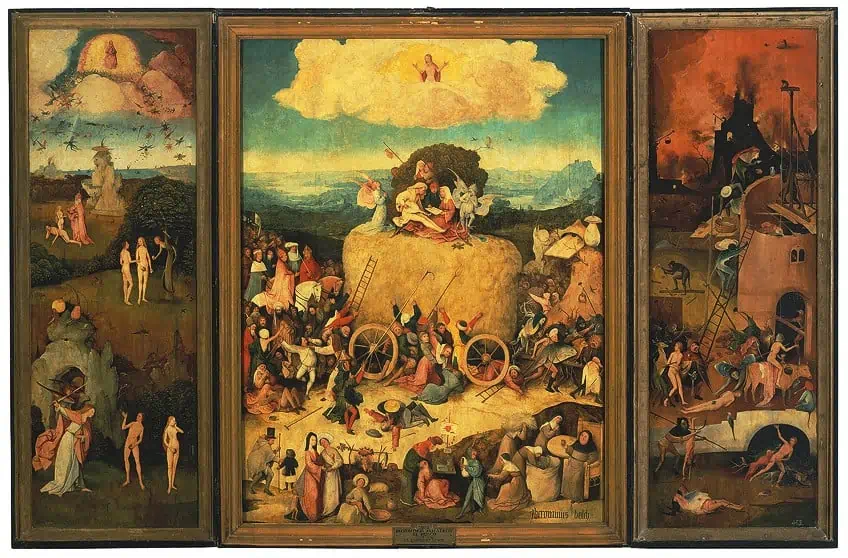
In the middle is a canvas portraying scenes of chaos and violence. There is a figure making its way along the path that runs through all three panels, and he was known as the Wayfarer. This character originally appeared in another of Hieronymus Bosch’s paintings.
Dull Gret (1563) by Pieter Bruegel the Elder
| Date Completed | 1563 |
| Artist | Pieter Bruegel the Elder (1530 – 1569) |
| Medium | Oil on panel |
| Location | Museum Mayer van den Bergh, Antwerp |
The Flemish artist showed a very different image of a voyage to the netherworld in this painting, with a rouge lady commanding a group of female warriors into the bowels of hell to attack and defeat it, pillaging anything that remained. The figure of Dull Gret moves over a monster-infested countryside towards the entrance of hell while her female troops plunder a home.
The monsters are symbols of the evils that are condemned there.
Gret is dressed in armor, including a breastplate, chain-linked gloves, and a metal helmet; her military outfit is insulted by the creature alongside her, who raises a drawbridge. “Gret” was a derogatory term for any bad-tempered, shrewish lady. Some historians conclude that it was an allegory of the contemporary intellectual zeitgeist’s “madness and foolishness”. Bruegel is mocking loud, demanding women.
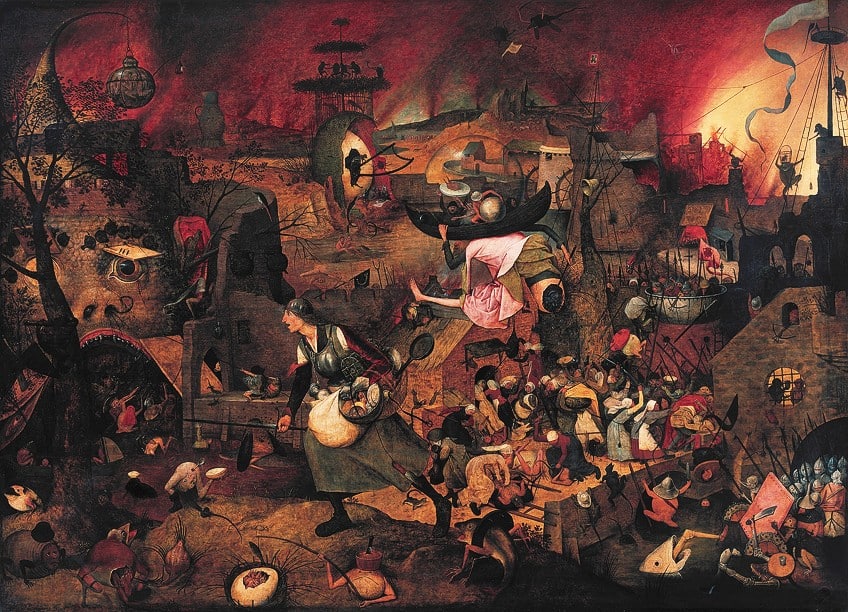
At the same time, he condemns the sin of greediness: despite being overburdened with things, Griet and her monstrous friends are willing to storm the jaws of Hell itself in their pursuit of more. It might also relate to anything dumb, courageous, or both, meaning that someone dull or ignorant may have greater courage and find themselves in difficulties, not yielding but making the most of it.
It could represent a woman overcoming hell and emerging with treasures, a psychological metaphor for fighting through difficulties to grow braver and stronger; to enter one’s private hell and conquer one’s demons.
Dante and Virgil in the Underworld (1622) by Filippo Napoletano
| Date Completed | 1622 |
| Artist | Filippo Napoletano (1589 – 1629) |
| Medium | Oil on slate |
| Location | Private collection |
This is one of several terrifying artworks that dealt with the story of Dante and Virgil. Most of the painting is extremely dark, with red shining through from between the arches and pillars – revealing masses of the damned writhing on the floor, trying to escape from the horrors inflicted upon them by the demons of the underworld.
The artist rendered this horrific hell artwork in great detail, and one can see the bodies of the damned being thrown from the building, where they land in the pits of hell and are tortured and devoured by the demons.
Dante and Virgil in the Underworld (1622) by Filippo Napoletano, located in a private collection; Filippo Napoletano, Public domain, via Wikimedia Commons
What sets Dante and Virgil in the Underworld apart from other artworks of its time is that most painters in those days were creating beautiful utopian scenes from the scriptures and not the hellish nightmare that Napoletano had dreamed up.
Satan Calling Up His Legions (1804) by William Blake
| Date Completed | 1804 |
| Artist | William Blake (1757 – 1827) |
| Medium | Tempera |
| Location | Victoria and Albert Museum, London |
The artwork is inspired by the first book of Paradise Lost, in which Satan gathers the rebel angels who have been driven out by God and condemned to Hell to fight their way back into Heaven. In terms of events, people, and landscape images, Blake’s artwork combines multiple sections from Milton’s text.
Blake’s utilization of gold leaf as a foundation layer for the tempera renderings of this theme may have served a symbolic function in this case as well.

Furthermore, the scaly figure reclining in the center of the bottom row of figures might be Dagon, the hybrid man/fish of mythology. Satan is located in the middle of the work, calling his legions, while Beelzebub is seated beneath him. Others of Blake’s time, like Thomas Lawrence and John Robert Cozens, also depicted this subject.
Pandemonium (1841) by John Martin
| Date Completed | 1841 |
| Artist | John Martin (1789 – 1854) |
| Medium | Oil on canvas |
| Location | Louvre Museum, Paris |
Christianity, according to John Martin, was crucial in bridging the divide between the academic preferences of critics and widespread commercial popularity. Unlike the Rococo artists, Martin realized that ethereal artworks of flying cherubs would not be well received by his viewers because they would be so far removed from the often tough, dirty, and even miserable everyday lives of many ordinary workers in both countryside and urban populations.
Martin’s style became illustrations like this, which he hoped would bring him income while also warning others not to sin.
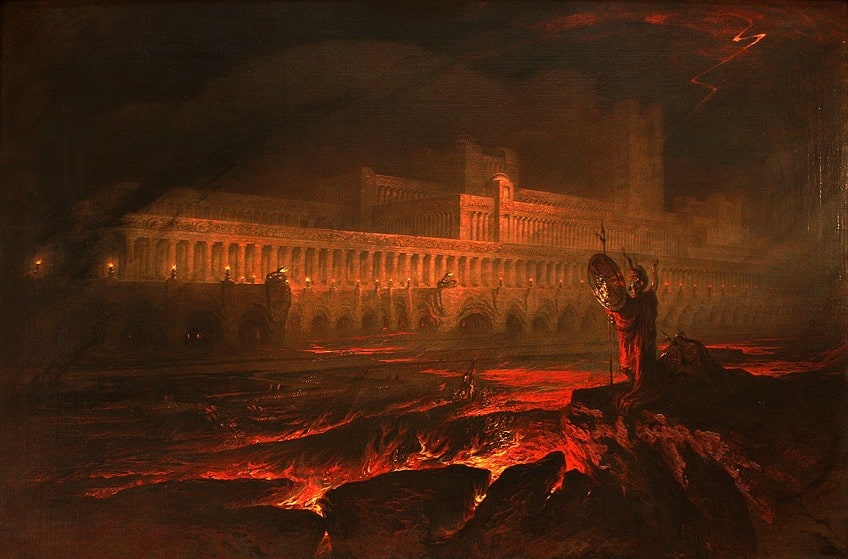
The terrifying artwork is based on John Milton’s classic novel, Paradise Lost (1667). The city was believed to have been constructed in less than an hour in the novel, greatly exceeding any construction ever created by men. The inside was packed with hideous demons waiting to fulfill Satan’s commands. The painting is rather impressive, with a lone man standing on the edge of what looks to be a raging river made of fire opposite a huge palace.
The golden shimmering walls reflect the intensity and fiery coloring of the flaming chasm below.
Dante and Virgil in Hell (1850) by William-Adolphe Bouguereau
| Date Completed | 1850 |
| Artist | William-Adolphe Bouguereau (1825 – 1905) |
| Medium | Oil on canvas |
| Location | Musée d’Orsay, Paris |
This would be the first and last painting that Bouguereau ever produced on this specific topic. The painting depicts Virgil accompanying Dante through hell’s eighth circle – the place reserved for liars and forgers. They stop dead in their tracks to observe a terrible struggle, a never-ending conflict to death.
The brutality of the assault is tangible: we watch one warrior viciously biting the other’s neck while ruthlessly kneeing him in his lower back.
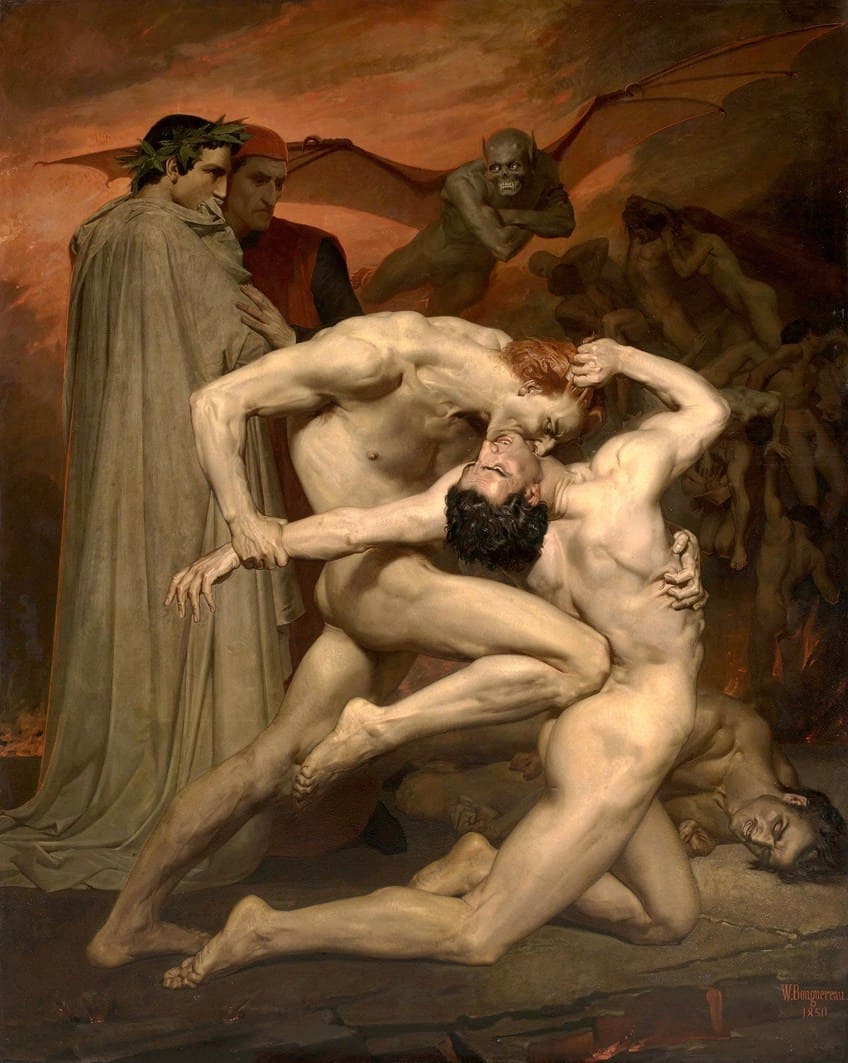
The stiff, straining muscles and the defiant, aggressive expressions show their anguish and suffering. However, there is beauty in this: the precise, strong bodies are represented in harmonic lines, implying a powerful, fluid strength. There is nothing fixed about the body postures; the image is a momentary flash of fighting in which we completely experience the motion and energy of the struggle. Dante Alighieri created the horrific depictions of hell that have influenced and disturbed Christian consciences since the Middle Ages.
Divine retribution for sin was a faint, vague idea before Dante; he gave it depth and terrifying substance.
Inferno (1908) by Franz von Stuck
| Date Completed | 1805 |
| Artist | Franz von Stuck (1863 – 1928) |
| Medium | Oil on canvas |
| Location | Metropolitan Museum of Art, New York |
Von Stuck’s art was mostly mythological, and the majority of his works included huge figures that reflected his love of sculptures. Stuck produced Inferno in 1908, just before the end of World War II, and it depicts the artist’s personal impression of hell. A serpent, flames, and demonic monsters are shown in the artwork in dark colors, punishing the people surrounding them.
Three humans are depicted in the artwork in a fetal posture, appearing to be in excruciating pain and misery, as one might expect hell to be.

Many saw von Stuck’s works as visionary art because he courageously examined the darker aspects of humanity in his art. His presentation of a more ominous topic was certainly unique and received praise from reviewers for his subject matter. His portrayal of hell’s atrocities fed the modernists’ passion for expressionism and surrealism.
The earliest depictions of hell in art hint at the early Christian assimilation of paganism and Christian beliefs. The Hellmouth, which depicts the entry to hell as the wide-open mouth of a terrible monster, is one such illustration. It originally appeared in Anglo-Saxon artwork, and it is said to have been inspired by images of the Norse mythology of the struggle between Fenrir and Odin’s son. Hell paintings were also very popular during the Medieval period when the subject of the Last Judgment was prominently portrayed. Renaissance paintings of hell were also abundant. A common feature of most depictions of hell in art is the inclusion of images of explicit torture. This was most likely incorporated to scare the viewers into questioning their life choices in fear of having to experience the hellish nightmares that were depicted in the hell artworks.
Take a look at our hell paintings webstory here!
Frequently Asked Questions
Why Were These Famous Paintings of Hell Created?
Most artworks that painters create are commissioned to be made. Many artworks of a religious nature were ordered by members of the clergy or religious patrons. Although scenes of hell seem like a rather odd choice for artwork, they were not meant to be aesthetically pleasing to begin with. Most of the time they were created for the exact opposite reason: to make the intended audience fear the consequences of a sinful life and hence live better ones. Other artists might have used the opportunity presented by the subject matter to explore and produce darker artworks that were usually not acceptable outside of a religious context.
What Was Featured in Hell Artworks?
The early works often featured the inclusion of a Hellmouth, which was like a creature with a wide gaping mouth that served as the entrance to the underworld. Another common feature of many terrifying artworks was an abundance of violence and torturous acts. Demons were often featured in the paintings, dragging people into the pits of hell to devour them. A common theme was the tale of Dante and Virgil’s descent into hell.
Jordan Anthony is a Cape Town-based film photographer, curator, and arts writer. She holds a Bachelor of Art in Fine Arts from the University of the Witwatersrand, Johannesburg, where she explored themes like healing, identity, dreams, and intuitive creation in her Contemporary art practice. Jordan has collaborated with various local art institutions, including the KZNSA Gallery in Durban, the Turbine Art Fair, and the Wits Art Museum. Her photography focuses on abstract color manipulations, portraiture, candid shots, and urban landscapes. She’s intrigued by philosophy, memory, and esotericism, drawing inspiration from Surrealism, Fluxus, and ancient civilizations, as well as childhood influences and found objects. Jordan is working for artfilemagazine since 2022 and writes blog posts about art history and photography.
Learn more about Jordan Anthony and about us.
Cite this Article
Jordan, Anthony, “Famous Paintings of Hell – Discover Scary Depictions of Hell in Art.” artfilemagazine – Your Online Art Source. September 22, 2022. URL: https://artfilemagazine.com/famous-paintings-of-hell/
Anthony, J. (2022, 22 September). Famous Paintings of Hell – Discover Scary Depictions of Hell in Art. artfilemagazine – Your Online Art Source. https://artfilemagazine.com/famous-paintings-of-hell/
Anthony, Jordan. “Famous Paintings of Hell – Discover Scary Depictions of Hell in Art.” artfilemagazine – Your Online Art Source, September 22, 2022. https://artfilemagazine.com/famous-paintings-of-hell/.


